This is a much needed updated version of the original blog. Why needed? Because congressperson Alexandria Ocasio-Cortez (whose policies I very much admire and support) just tweeted the big nationalist lie, the Puerto Rican nationalist’s version of the Confederacy’s Lost Cause Myth– that is; that possessing the Puerto Rican flag was punishable with ten years in jail between 1948 and 1957.
This is simply false. Absolutely, unequivocally false.
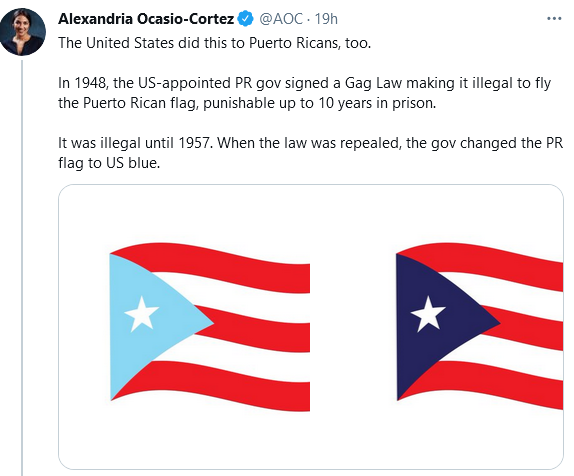
Who could use the Puerto Rican flag was a disputed issue as far back as the 1930s. But it is not because it was prohibited. In fact it was widely unofficially used as the territory’s flag. In the early 1930s, the Nacionalistas, under the leadership of Albizu Campos, made clear that the flag belonged to them. Throughout this period, socialistas and liberales who used the Puerto Rican flag became the targets of nationalist violence.
I repeat: the nacionalistas targeted those using the Puerto Rican flag who did not belong to the Nationalist Party!
Two decades later, nationalist leader, Pedro Albizu Campos, who had been convicted of sedition and conspiracy to overthrow the government of the United States in 1937, returned to Puerto Rico from New York City on December 15, 1947, four years after been released from federal prison on probation.[i] He immediately started a campaign to derail the PPD’s projects and ordered the mobilization of the Ejército Libertador.
Only a day after his return Albizu Campos held a press conference and warned the U.S. that after depleting all peaceful means to obtain independence, the “Nationalist Party would resort to the use of force to attain its goals.”[ii] His threats also targeted the first elected governor of Puerto Rico, Luis Muñoz Marín. Albizu Campos declared that “Muñoz must be stopped, and we will stop him.” Muñoz Marín publicly warned Albizu Campos to abstain from violence. Albizu Campos responded by questioning Muñoz Marín’s Puertorriqueñidad while demanding that the Puerto Ricans abstain from voting in the 1948 general elections.[iii]
He also condemned school instruction in English in Puerto Rico, declared that “every person serving in the Selective Service Boards should be shot”, and commanded the Nacionalistas to start arming themselves with “revolvers, rifles, guns, shotguns, knives and daggers to defend the cause of the Revolution.”[iv] Despite Muñoz Marín’s warnings Albizu Campos’s campaign continued unabated. On September 23, 1950, during the anniversary of the Lares Revolt of 1868, he addressed the crowd gathered in Lares’ Plaza Pública. He spoke against P.L. 600 and harshly condemned the participation of Puerto Rican soldiers in the Korean War. He ended his speech by calling the Puerto Ricans to defy the U.S. and its colonial pawns in the same way that “the men of Lares defied despotism, with revolution!”[v]
That the Nacionalistas were planning a coup or insurrection was hardly a secret. Emboldened by the apparent inaction of the insular government, Albizu Campos continued his call to arms against the U.S. and its representatives in the Island; Muñoz Marín, the Populares, and anyone who served, worked, or were in any way related to the metropolis.
In his speeches, Pedro Albizu Campos defied the hated Gag Law (Ley de la mordaza) of 1948. Jesus T. Piñero, as appointed governor of the Island, signed Law 53 (the Gag Law’s insular nomenclature) on June 10 1948. Muñoz Marín was still the president of the insular senate, and Puerto Rico’s most powerful politician, when the bill was passed.
The Gag Law declared a felony to persuade people or to plead for overthrowing the Island’s government by violence or force. Printing or publishing any material encouraging people to engage in such activities and creating any kind of organization to carry out any of these acts became felonies under this law.
The law, which was derogated in 1957, closely resembled the U.S. Alien Registration Act (also known as the Smith Act) passed by Congress on 29 June, 1940. This act made it illegal for anyone in the United States to advocate, abet, or teach the desirability of overthrowing the government.[i]
A month earlier, the Insular Police had established the Internal Security Unit, which worked closely with the local FBI unit to keep the Nacionalistas, Communists and Independentistas under surveillance.
While Communists and other leftist groups were the primary target of the Smith Act, the insular version was instrumental in the suppression of Nacionalistas and other independentista groups in Puerto Rico. The insular government, despite appearances, was not inactive with regard to the nationalist threat.
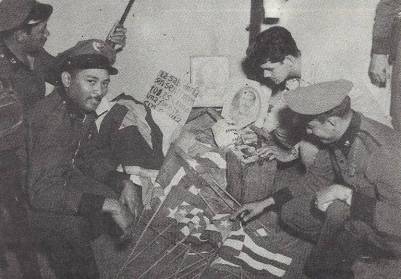
Despite personal and popular accounts, the Puerto Rican flag and what would become the anthem of the ELA, la Borinqueña, were not prohibited neither was possessing the flag or singing the la Borinqueña admitted as evidence to sentence people to jail.
Did overeager and abusive police officers profile people for owning the flag? More than likely. The illegal surveillance conducted by the FBI and the Puerto Rican police is well-documented and known to Puerto Ricans. We grew up with it and our press covered it- extensively! We even played “reading las carpetas” as a special Puerto Rican version of “spin the bottle”. Back to the point, possessing and displaying the flag may have got you under surveillance but not sentenced to jail.
There are pictures taken by reporters after the Insular Police raided nationalists houses (and safe houses). You can see that as part of the cache they found (revolvers, rifles, ammunition, explosives) they also displayed nationalist iconic paraphernalia such as the flags. That does not mean that the flags could be used as evidence- they were simply art of everything found during a search.
Moreover, what would become the official Estado Libre Asociado’s flag was widely in use in Puerto Rico, before, during, and after the Gag Law. When the All_Puerto Rican 65th Infantry (the Borinqueneers) returned to the island after serving in Africa, Italy, France and Germany during WWII, they were received by tens of thousands of people waving both the US and the Puerto Rican flag. Both the 65th and the Puerto Rico National Guard used the flag.
The founder of the Center for Puerto Rican Studies, Frank Bonilla, is a witness of both the use of the flag and the anthem. As a Puerto Rican New Yorker, he enlisted in the US Army during WWII. After getting hurt during the Battle of the Bulge, he was sent to the All-Puerto Rican 65th Infantry Regiment, the Borinqueneers. There he came in touch with his puertorricaness. He commented that he was impressed by the solemnity with which the Borinquneers responded to the raising of the flag and the playing of the anthem while being part of the final push to defeat Nazi Germany! After the war, he made his first visit to Puerto Rico (the 65th’s home base) and he witnessed the thousands of peoples welcoming them with both US and Puerto Rican flags.
The march of the 65th, el sesenta y cinco or the Borinqueneers, was actually La Borinqueña, and their version became the official anthem of Puerto Rico in 1952. In fact we have video of the first official raising and playing of the national anthem celebrating the inauguration of the ELA on July 25, 1952.
Not only were people not sentenced to jail for owning the Puerto Rican flag but during the Korean War (1950-53), leading elements of the 65th involved in an attack would carry the flag to raise it after taking enemy positions. Carrying the flag in combat was the ultimate honor during the Korean War as the men of the 65th used national pride to overcome deficient training and leadership, inadequate artillery and air support, and an ever growing language and cultural barrier to continue functioning as a combat unit.
The Borinqueneers even conducted a ceremony in a forgotten hill in a Korean battlefield to celebrate the ELA’s inauguration.

We have many accounts and news of these events but we also have the pictures as it was part of a deal to reform the colony and thus, portraying the Puerto Rican colors in local, national and international news was a very effective publicity campaign used by the United States and the architects of the commonwealth to claim that Puerto Rico was no longer a colony. Both the reformed colonial state (ELA) and the United States were interested in displaying the flag as a sign of the will of the people of Puerto Rico, decolonization, and autonomy.
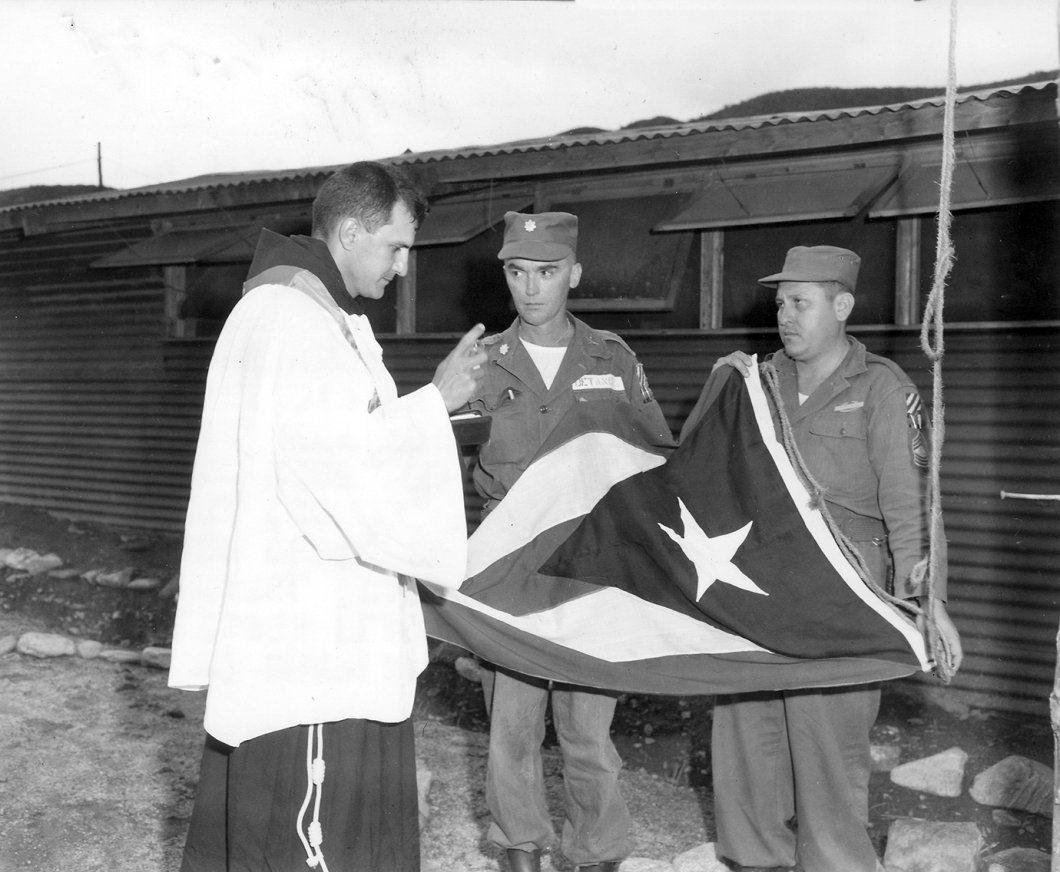
On October 12, 1950, the press announced that the 65th was fighting in Korea. The mood that day came to resemble a holiday more than anything else. The Island’s newspapers were full of stories, pictures of the 65th, and the ceremonies held previous to their departure. The private sector joined the chorus with paid advertisements wishing the 65th a prompt return, and exhorting Puerto Rican soldiers to uphold the ideals of democracy and freedom. In both leading newspapers, El Mundo and El Imparcial, the tone was the same. The latter proclaimed, “As it was yet another symbol of the United Nations, under the American flag flies the flag of the 65th Infantry Regiment, this flag flies today in Korea.”[i] The colors of the 65th came to represent not only the regiment, but Puerto Rico as a whole. [ii] Soon the Puerto Rican soldiers in Korea would carry the official flag of the commonwealth into battle. Excerpt from Soldiers of the Nation, Military Service and Modern Puerto Rico, 1868-1952

The flag was so important to the Puerto Ricans fighting in Korea that in some cases patrols were sent to recover a flag left in the field or captured by the Chinese Communist Forces or the North Koreans. The picture above came with the title: Recovered Puerto Rican flag with bullet holes. Korea, 1952; and the quote: “The Communist enemy does not have enough ammunition to keep our flag from rising again.”
The recovered flag was sent to Puerto Rico with El Mundo’s Puerto Rican war correspondent (Combas Guerra). Combas Guerra had arrived in Korea with a new flag for the 65th regiment to replace the bullet-riddle one. After his return to Puerto Rico, El Mundo gifted the battle-sacred flag to the University of Puerto Rico.There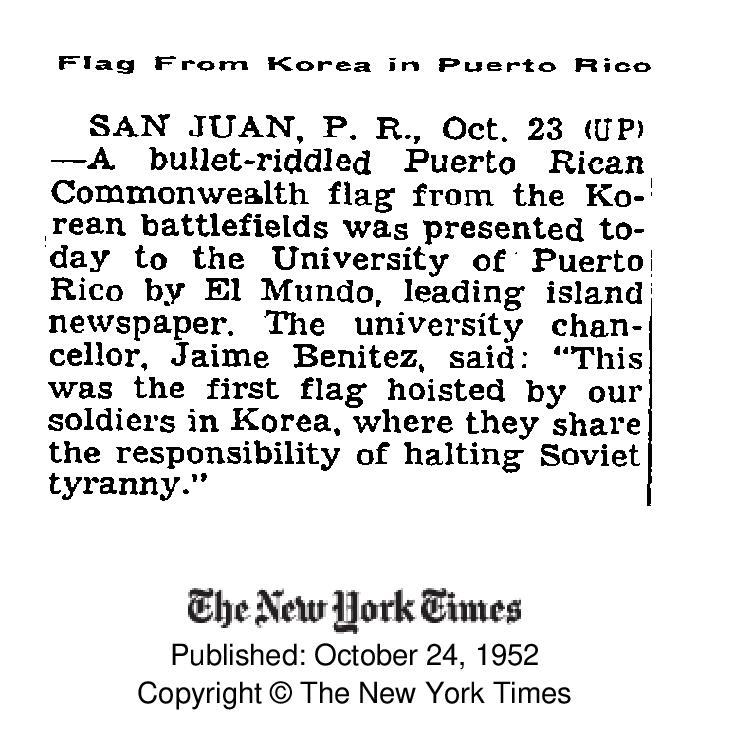
I could use dozens and dozens of examples of how ubiquitous the flag actually was- and how important it was for ALL Puerto Rican, and as part of the ELA’s iconography- but why beat a dead horse?
Representative Ocasio-Cortez also claims that Puerto Ricans display the flag so ubiquitously as an act of resistance to colonialism. This assertion is also a myth that defies logic.
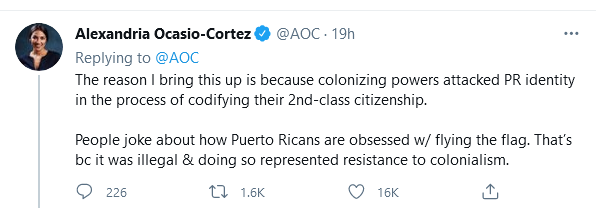
To begin with, we have to do mental gymnastics to believe that the growing Puerto Rican community in New York and the Eastern Seaboard felt safer displaying the flag in the belly of the beast than in Puerto Rico. Makes sens, if you don’t think about it.
The main reason why the Puerto Rican flags started to be so ubiquitously displayed has to do with the ELA’s mainstreaming of the flag, putting it everywhere, and including it in what eventually turned into Puerto Rican Day Parade Day going back to the early 1950s. The flag was not criminalized, in fact, its used was widely promoted by the ELA as a symbol of “autonomy” and the “compact” they had negotiated with the United States. As a symbol of the Puerto Ricans, displaying the flag was also a claim of belonging and respectability.


It is truly disheartening that the most powerful and influential Puerto Rican in Congress, Alexandria Ocasio-Cortez, has fallen for the big nationalist lie. She has fallen for a myth that is easily debunkable with a quick google search. She has the means at her disposal to get the facts straight- as she usually does. Why not taking the time to get this right? Is Puerto Rico just part of a larger narrative, a pawn? Equating Puerto Rico’s history to those of the Palestinians makes a mockery of our history and appropriates the pain of the Palestinians.
I can’t even begin to wrap my head around the Representative Ocasio-Cortez’s motivations- but an apology to both the Puerto Ricans and the Palestinians is in order.
I also recommend that if the representative wants to be an effective voice and work towards the decolonization of the archipelago- she must wiling to learn our history in its complexity and not rely on nationalist propaganda and “radical” publications that misrepresent our history and uses us as props. For denying a people of their history and using it for politcal goals is the ultimate form of colonialism.
http://www.nebraskapress.unl.edu/university-of-nebraska-press/9780803278677/

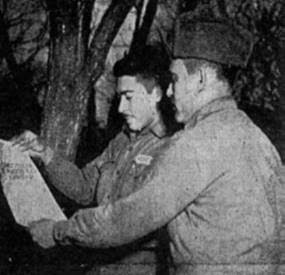

[i] Mathews, La política Puertorriqueña y el Nuevo Trato, 249; and Maldonado, Puerto Rico’s Democratic Revolution, 147-48. On March 5, 1936, Albizu Campos and other seven Nationalist leaders were arrested and charged with sedition and conspiracy to overthrow the government of the United States The next month, a Federal Grand Jury submitted accusations against Albizu Campos and other leaders of the party.
[ii] Seijo Bruno, La insurrección nacionalista, 39.
[iii] A balance account of the public confrontation, mostly through discourses, radio speeches and commentaries to the press, can be found in Rosario Natal, “Muñoz y Albizu: el choque en la víspera de la insurrección”, 309-341.
[iv] Seijo Bruno, La insurrección nacionalista, 40.
[v] Seijo Bruno, La insurrección nacionalista, 42-43 citing Albizu Campos, Paredón Records, P-2501.
[i] The U.S. Alien Registration Act also required all alien residents in the United States over fourteen years of age to file a comprehensive statement of their personal and occupational status and a record of their political beliefs. Within four months a total of 4,741,971 aliens had been registered. See Díaz Soler, Puerto Rico: Sus luchas por alcanzar estabilidad económica, definición política y afirmación cultural, 319-323.
[i] El Imparcial de Puerto Rico, November 12, 1950, CPUPRM.
[ii] El Imparcial de Puerto Rico, November 12, 1950, CPUPRM.


You should really look at the charges brought against thousands of Puerto Ricans and see that they were sentenced for possessing a flag…..
LikeLike
That is exactly the argument. That no one has ever produced a court record to show that a single Puerto Rican ever went to jail for possessing the flag. Not once. So if you have the evidence – public court records- please produce them.
LikeLike
I have been seeking the actual text of Ley 53. so far my search has been fruitless. can you provide a source of the direct verbiage of Law 53?
LikeLike
Someone sent it to me a couple years ago. I can’t find the file. But I posted it on FB wall. I’m sure someone will send it. I’ll send it to you then.
LikeLike
We were not taught about this law at all in school (native NYer). What was the penalty for displaying the flag?
LikeLike
We were not taught about this law at all in school (native NYer). What was the penalty for displaying the flag? Is there a copy of the law somewhere? I’m interested to learn more about this.
LikeLike
There was no penalty for displaying the flag or singing the anthem. What was punishable was advocating for the violent overthrow of the government of Puerto Rico- which is a violation of freedom of speech. Like I mention in the article, having the flag along with nationalist iconography would get you under surveillance but you would not go to jail for possessing or displaying the Puerto Rican flag or singing the anthem.
LikeLike
“You could not go to jail.” Explain this to Abizu Campos whom was systematically tortured with radiation as well as the thousands of jailed nationalists. Also, take a look at the pharmaceutical companies in PR and how they used thousands of Puerto Rican women as ginny pigs for birth control development. Not even going to get into how Domino Sugar exported the masses in PR. Do your homework.
LikeLike
Albizu Campos did not go to jail because he had a Puerto Rican flag. In fact, no one did. There were never thousands of nationalists in jail. Read a book that is actual history. Albizu Campos was not subjected to radiation in La Princesa. He was probably exposed to radiation in federal penitentiary just like other thousands of federal inmates. Had he been exposed to radiation in La Princesa everybody would’ve been contaminated and died of it. That’s is a scientific fact. Albizu had early senile dementia and even when visited by his closest aides he would tell them he was been radiated at that very same moment. There is history and there is the myth created by politicians.
LikeLike
I understand the point you are trying to make. You point to proof of a lack of prosecution by stating many examples of owning or displaying the flag when the law was in force. However that does not mean it was legal to own or displace when the law was in force, or that selectively enforcement did not occur. What was the basis for the arrest of Francisco Matos Paoli? Just because the enforcement of the law was uneven does not mean that it was against the law and the punishment for violating the law was written into the law. Also what is the quick google search you are referencing because when i google law 53 puerto rico all results except yours state the law stated it was illegal to own or display the Puerto Rican flag.
LikeLike
I’m referencing the law itself. The law did not criminalize possession of the flag, or singing the national anthem. That is a myth.
LikeLike
Explicitly within the law it does not state that it is illegal to posses the flag or sing the national anthem. However it did state it was illegal to do any of these things with the intent to overthrow the insular government. Doing on the ground research and interviewing our parents and grandparents who lived in these times and they will tell you that was their direct understanding of this law. There is a reason why, specifically to the crux of your statement “Back to the point, possessing and displaying the flag may have got you under surveillance but not sentenced to jail.” Again what was the cause of arrest for the prolific Puerto Rican poet Francisco Matos Paoli on November 2nd 1950? What extensive research have you or any of your students done on arrest records of this period and running down statements from those arrested during this time, that made you come to this conclusion and definitively state this?
Again to parse and be exact sure your statement may be literally correct, he was not sentenced to jail simply for having the flag but that was the cause for his arrest and the cause for his conviction was the speeches he made agitating for independence, and the possession of the flag, not simply the possession of the flag. However as the possession of the flag was the cause for the arrest, sufficient causality exists to state that the interpretation of Law 53 did result in at least 1 arrest due to possession of the flag. Was this the only one? Possibly but possibly not. There are other examples that have been in the record but that had other potential causalities. To make a statement like that with the evidence in place without doing an extensive review of arrest records of the time, news stories like from El Mundo and others that covered these arrests, and from interviews and other records pushes it.
The difference between what is explicitly stated in a law vs what is implicit and the actual application of the implicit and its impact on the populous writ large is significant and not just semantic.
LikeLike
He was not arrested for possessing the flag. That is your interpretation. That some nationalists thought that possessing the flag or singing the anthem would get them sentence to jail is irrelevant. People believe the earth is flat or the moon landings fake, that doesn’t make it so. I do History not myth, neither propaganda or ideology. You don’t like what I prove here, disprove it- with facts. Not arguments. And the fact is that the Puerto Rican flag was widely in display throughout the whole island. There is archival, photographically and visual effects evidence. And the application of the law didn’t condemn anyone to jail for possessing the flag or singing the anthem. That’s a fact.
LikeLike
My interpretation of what exactly? Interviews with him explicitly state that. http://www.peacehost.net/WhiteStar/Voices/eng-matos.html There are also articles in El Mundo from that era The microfiche from El Mundo from that era are available at El Centro as stated by the Library of Congress.
You state it is a fact that he was not arrested due to possession of the flag, you state it is my interpretation. As a social scientist with a PhD what is the referential basis of your factual statement?
LikeLike
Again, the law did not provide for anyone to be sentenced to jail time for possession of the flag (widely displayed and use in PR at the time) or singing the national anthem. That is simply a lie. You can demand access to the PUBLIC records of Paoli’s arrest and trial (without using the Freedom of Information Act) or of any nationalist, and confirm this because these are public. The link you sent me is someone’s opinion on why they were arrested. It means very little. It is their perspective. You can get access to these files. Make it your mission. But, I will tell you this, if there were a shred of evidence to support those incredibly ridiculous claims (a false narrative I grew up with), it would’ve been used by now to denounce the ELA. Like I said, there is history, myth, and propaganda. I do the first and denounce the other two.
LikeLike
That is what i find incongruent. You state you do history. You state it is a fact that Paoli was not arrested due to possession of the flag. You diminish the firsthand witness statement of why he was arrested and then put the burden of proof on me to back up the firsthand witness statement by going into the public records. Either retract that it is a fact that he was not arrested for said reason, or say you have your doubts but this is not something worth pursuing because the preponderance of evidence in other cases allows you to make an observational conclusion which factually leaves the thread dangling, or back up your statement of fact with the explicit evidence.
LikeLike
I have nothing to retract. And the burden is on you. Have a great life spreading myths.
LikeLike
Hence the state of academic and intellectual rigor.
LikeLike
There is preponderance of evidence I provided in just this blog. You want to believe a myth- go ahead.
LikeLike
One last thing, he was a member of the nationalist party, one that waged war and committed all kinds of attacks against the colonial and post/colonial administration, so flag or not flag he was under surveillance. It is actually, that simple.
LikeLike
*own or display
LikeLike
The funny thing is there is evidence that gets erased and removed from history and we find out centuries later. The idea that a Dr. Can’t see the actual evidence beyond his own teachings and research is probably more evidence of indoctrination. I personally know people who were tied to the story and my parents were from that era and also explained and told me. Your asking for court records and evidence of something that can be evidenced thru history as an issue. The way you are discrediting history because you haven’t found the evidence yet is dangerous
LikeLike
Wow Joey, you know who also calls historians and all kinds of scholars dangerous? Fascists. The extreme right in the United States and all over the world does that over and over. I did not claim that I haven’t found them. I sustain that possessing the flag, or singing the anthem, could not be considered evidence during a trial because the law did not allow for that. The records of the trials are public domain. It is up to you to keep believing propaganda and myth. And that is a dangerous as being a deranged Trumper.
LikeLike